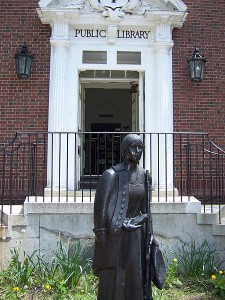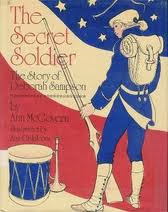Despite the fact that women were not allowed to join the military until the 20th century, several women still fought as secret soldiers during the American Revolution. One such woman was Deborah Sampson from Plympton, Mass.
Sampson, a direct descendant of the Mayflower pilgrim William Bradford, grew up in poverty. Like most children in poor families, she was hired out as an indentured servant until the age of 18. After she was released from indentured servitude, she worked as a local school teacher.
After the Revolutionary War broke out, Sampson decided to join the military. Like the secret female soldiers in the Civil War, Sampson was young, poor, unmarried and wanted to serve her country like men did while earning some money in the process. Since she didn’t have any family to take care of, already held a low rank in society and had limited opportunities to earn money as a woman, she had very little to lose.
 |
| Engraving of Revolutionary War soldier Deborah Sampson. Published in “The Female Review” by Herman Mann, circa 1797 |
Disguising herself as a man by sewing herself a man’s coat, waistcoat and breeches, Sampson traveled to Worcester in May of 1781 (although some sources indicate she enlisted in 1782), where she enlisted in Captain Webb’s company in the 4th Massachusetts Regiment, under the alias Robert Shurtliff.
The war had already moved on to the New York area by the time Sampson enlisted and she was sent to fight as a light infantryman in the Hudson Valley. According to Sampson’s biographer, Herman Mann, who personally interviewed Sampson for his book “The Female Review,” Sampson found war to be exhausting and terrifying:
“She says she underwent more with fatigue and heat of the day, than by fear of being killed; although her left-hand man was shot dead at the second fire, and her ears and eyes were continually tormented with the expiring agonies and horrid scenes of many others struggling in their blood. She recollects but three on her side who were killed, John Bebby, James Battles and Noble Stern. She escaped with two shots through her coat, and one through her cap…She now says no pen can describe her feelings experienced in the commencement of an engagement, the sole object of which is to open the sluices of human blood. The unfeigned tears of humanity has more than once started into her eyes in the rehearsal of such as scene as I have just described.”
While fighting in New York, Sampson was wounded in battle. “The Female Review” states she was shot in the thigh during a skirmish with Tory soldiers, but according to her pension application in 1818, Sampson stated she received the wound at the Battle of Tarrytown. After removing the bullet herself, the wound never healed properly and caused her pain and discomfort for the rest of her life. She was wounded again four months later when she was shot through her shoulder. Although Sampson survived her wounds, she eventually came down with a fever shortly after being dispatched to fight in Pennsylvania and was hospitalized. It was then that the doctors discovered her true identity. After Sampson recovered she was given a honorary discharge and returned home to Massachusetts where she eventually married and had three children.
Sampson kept a journal of her experiences during the war but it was lost in October of 1783 after a boat she was traveling on while returning from Pennsylvania capsized during a storm. Years later, in 1797, Sampson met Herman Mann who worked with her to publish her biography “The Female Review.” Following publication of the book, Sampson embarked on a public speaking tour throughout eastern New York and New England. During her performances, she dressed in her male uniform and performed maneuvers from the manual of arms.
Like many soldiers of the revolution, Sampson had difficulty trying to obtain a pension. After she campaigned unsuccessfully to secure a pension in 1790, she became discouraged and feared Congress would never award her any money for her role in the war. With the success of her biography and speaking tour, Sampson renewed her campaign and gained the support of Paul Revere, who visited her farm in 1804 and wrote a letter to Congress stating “I think her case much more deserving than hundreds to whom Congress have been generous.” The following year she was finally awarded a pension and eventually won a general service pension in 1821.
Sampson died of yellow mountain fever in April of 1827 and was buried in Rock Ridge cemetery in Sharon, Mass. After her death, several statues and monuments were erected in her honor in Sharon. Over a century later, the Massachusetts legislature named Sampson the official state heroine and declared May 23 “Deborah Sampson Day.”

Statue of Deborah Sampson at the Sharon Public Library
Deborah Sampson’s memoirs “The Female Review” published in 1797
Sources:
“The Female Review”; Herman Mann, Deborah Sampson; 1797
“Women and Children First: Nineteenth Century Sea Narratives & American Identity”; Robin Miskolcze; 2007
“Women in the Military and Armed Conflict”; Helena Carreiras; 2008
“Writing Early American History”; Alan Taylor; 2005
PBS: Freedom: A History of U.S. Biography: Deborah Sampson: http://www.pbs.org/wnet/historyofus/web02/features/bio/B01.html
Massachusetts Historical Society: A Woman Soldiers in the Revolution: http://www.masshist.org/database/358use-onview-id
National Women’s History Museum: Deborah Sampson: http://www.nwhm.org/education-resources/biography/biographies/deborah-sampson/








1 comment:
i love this site its helping me with my report
Post a Comment